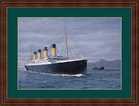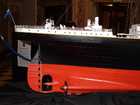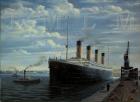|

Joined: 2007/1/26
From
Posts: -1
Group:
Registered Users
|
For decades after the disaster, there was little doubt about what sank the Titanic. When the "unsinkable" ship, the largest, most luxurious ocean liner of its time, crashed into an iceberg on its maiden voyage in 1912, it took more than 1,500 of its 2,200 passengers to the bottom. As the ship slipped into the North Atlantic, so, too, did the secret of how and why it sank.
China Rocket Launches, Spacewalk Next
Two government investigations conducted immediately after the disaster agreed it was the iceberg, not any weakness in the ship itself, that caused the Titanic to sink. Both inquiries concluded the vessel had gone to the bottom intact. Blame for the incident fell on the ship's deceased captain, E. J. Smith, who was condemned for racing at 22 knots through a known ice field in the dark waters off the coast of Newfoundland. The case of the Titanic was considered closed.
But lingering questions about what might have sunk the seemingly indestructible ship never completely disappeared. In 1985, when oceanographer Robert Ballard, after years of searching, finally located the ship's remains 2.5 miles down on the ocean bottom, he discovered that it had, in fact, broken in two on the surface before sinking. His findings made the Titanic rise again in the public imagination. Why had it cracked, experts wondered? If the official inquiries were wrong, was the invincible Titanic weak? A few years after Ballard discovered the wreck, the first pieces of the ship were brought to the surface, raising even more eyebrows when they seemed to offer physical evidence that low-quality steel might have caused the disaster. In 1997, James Cameron's film Titanic, largely mirroring the scientific consensus at the time, seared Titanic's terrifying last moments, with its stern soaring high into the air before it cracked in two and disappeared, into popular memory.
Still, the search for answers about the Titanic didn't end there. In two new books, a group of historians, naval architects, and materials scientists argue that fresh evidence has further unraveled the familiar story of the Titanic, raising more questions about what caused the disaster. In What Really Sank the Titanic: New Forensic Discoveries, Jennifer Hooper McCarty, a materials scientist at Oregon Health and Science University, and Tim Foecke, a scientist at the National Institute of Standards and Technology, make the case that it wasn't the ship's steel that was weak; it was the rivets, the all-important metal pins that held the steel hull plates together. Titanic's Last Secrets, to be published next month, describes the work of Richie Kohler and John Chatterton, wreck-diving historians who believe two recently discovered pieces of the Titanic's bottom prove the ship's stern never rose high in the air the way many Titanic experts, including Cameron, originally believed. The two divers, whose discovery of a lost German U-boat was chronicled in the book Shadow Divers, say the ship broke up and sank while still relatively flat on the surface—a potential sign of weakness, they believe, that was covered up after the disaster.
When the Titanic's keel was laid down in 1909, Harland & Wolff, the Belfast shipbuilder that constructed the ship, certainly didn't believe its design would still be controversial a hundred years later. Built in response to a rival company's construction of a new generation of fast liners, Titanic and her sister ships, Olympic and Britannic, were the biggest ships ever made—from bow to stern, they were almost 900 feet long, dwarfing even the world's biggest skyscrapers. Specially outfitted to handle the challenges of the North Atlantic, including big waves and major collisions, they were also supposed to be among the safest. The Titanic could stay afloat with four of its 16 watertight compartments flooded, more than anyone could imagine on a ship of its size.
|
 Titanic.com - Titanic News, Photos, Articles & Research | Forum Index
Titanic.com - Titanic News, Photos, Articles & Research | Forum Index Titanic historic
Titanic historic  *NEW* evidence on why the TITANIC sank!
*NEW* evidence on why the TITANIC sank!
 Bottom
Bottom  Previous Topic
Previous Topic  Next Topic
Next Topic 14 Votes
14 Votes  Top
Top  Previous Topic
Previous Topic  Next Topic
Next Topic






















 Topic options
Topic options Print Topic
Print Topic Threaded
Threaded Newest First
Newest First Titanic98
Titanic98





 You cannot start a new topic.
You cannot start a new topic. You can view topic.
You can view topic.
